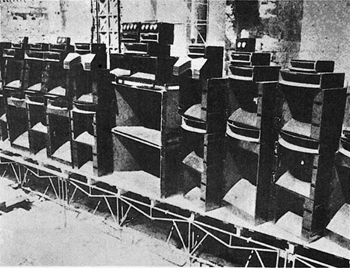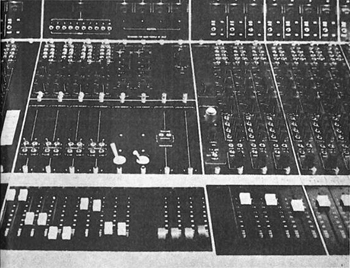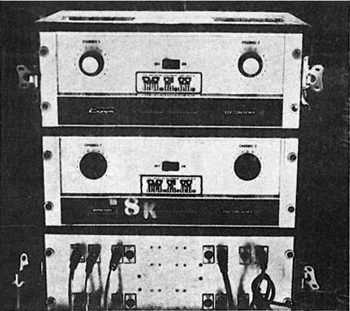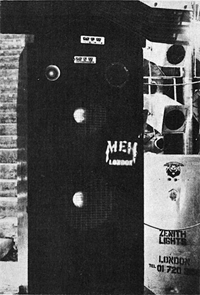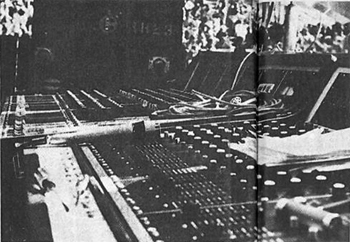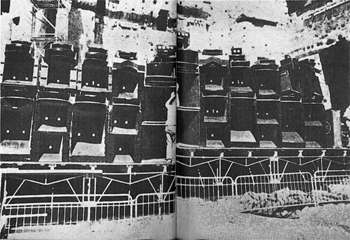The Who’s PA: 1975–1976
In 1975, additional wedge monitors placed at the front of the stage for vocal foldback, so each position has two, representing the front-stage foldback setup used on virtually every stage today.
In October 1975, Bob Pridden began working with Showco Sound of Dallas, Texas, for the Who’s sound system. The Showco PA was used in North America in November and December 1975 and March, August and October 1976.
For UK/European shows, the PA was supplied by Marshall Equiment Hire (MEH) of London.
And Tasco built the PA for the 31 May, 1976, Charlton show.
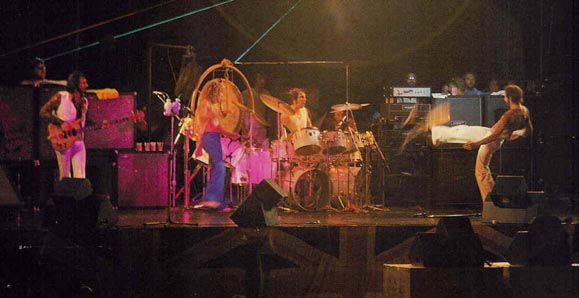
1976, with floor wedge monitors visible across front of stage. Courtesy whocollection.com.
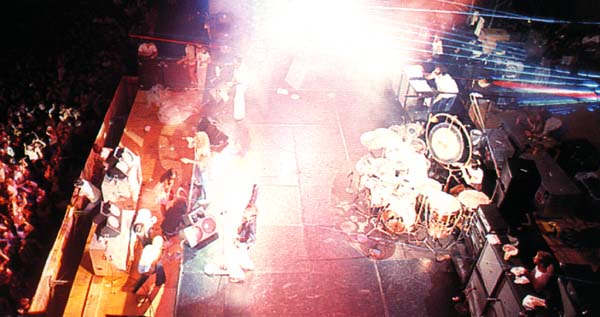
1976, from atop the stage, with floor wedge monitors visible across front of stage.
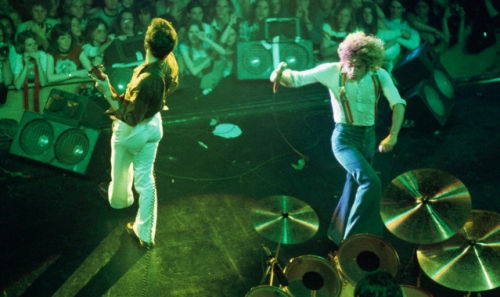
27 March 1976, Winterland Auditorium, from atop the stage, with floor wedge monitors topped with lenses visible across front of stage.
Selected quotes
All quotes and references are copyright their original owners and are included for reference only.
From 2015 Sound on Sound interview with Bob Pridden:
Bob is famously credited with playing a key role in coming up with the design for wedge floor monitors. How did those first wedges come into fruition and how did they develop from there?
“Oh crikey, I don’t know how we came up with them!” he laughs. “They were really antique at the time though! They looked like rabbit hutches and that’s what I used to call them. They were just these boxes on the stage with wire grilles. They look a bit smarter now but they haven’t changed that much. They basically have better speakers now, maybe better horns, but they haven’t changed that much really. We didn’t use wedges with Bob Heil or Dave Hartstone. We only used side fills and that’s why everyone’s a little bit deaf, I think, because we had two lots of four, two in each corner. That setup gives you a great sound but we can’t use them anymore. They’re too loud, but it was undoubtedly the best sound we’ve ever had on stage — it was just there! The first wedges we had were made by a company called Tasco. The horn was in another box you clipped on the top but they were always falling off and what have you. Then, of course, they got more and more developed and we started using a company in America called Showco. They were the first really great monitors. We bought some from them and used them all around the world. They were absolutely great — huge wedges — but the sound was superb! I think we had about eight of them and then, from there, we went to using Clair Brothers and their wedges. I loved their AM12s. They were great wedges but then dB Technologies came out with their wedges and I thought ‘Look no more!’ The dB Tech system had been so well designed. One of the things that I noticed in general was that you could hear the bass coming back from the PA, but dB Tech cancelled that out completely and it really cleared up the sound on stage.”
From 1975 International Musician and Recording World interview with Bob Pridden:
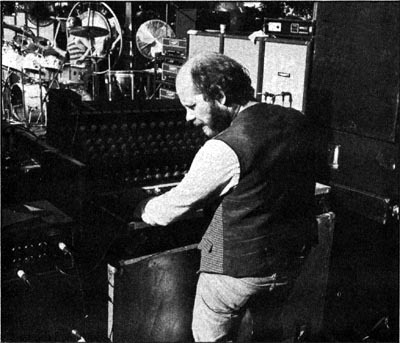
Ca. 1976, Bob Pridden running the Mavis desk at stage left.
“With The Who,” Bob explained, “I used to always have to mix the sound onstage, because the act relies on a lot of lip-reading between Pete and I or Roger and I. I’ve done masses of tours and gigs with other people when I’ve been out front mixing, and it’s great. I did it once with The Who and I felt almost selfish. I like to be onstage beside the band because there’s that much more contact.
“What I usually do is use two 4560 bins in a stack with a 2440 lens horn on the top of each one. We have two stacks on each side of the stage, so that’s eight bins and four horns just for vocals. We also use three-way stacks for tapes. I feed them through their own separate system on stage, so it’s almost as if there was someone up there playing. It gets a bit confusing at times but it’s a lot easier than it was. Now we’re using someone out front so I can concentrate more on what I’m doing. I used to have two Mavis mixers, a tape mixer, echo units on both systems and I really had to be like an octopus. It was getting a bit out of hand for me, and I felt as though I was cheating The Who, because someone must go out front. This is the first tour we’ve had someone out front, and it’s working out really well, because I can concentrate on my own mixing.
“The desk I use is a Mavis 15 channel four out board. Groups 1 and 2 power stage left and right stacks on a stereo three-way crossover, and I cut it off at 6k, so we don’t really get into the feedback problem. Groups 3 and 4 are for Pete and John’s slant-back monitors respectively. You can’t use a slant-back for Roger because of the way he swings the mike about. It would be smashing into the monitors or feeding back all the time. Also, we have two monitor outputs on the board, one of which I use for a slant-back behind Keith, so he can have bass drums and snare through it. For the tapes, we use a mixer, which was built by Alice for us. It’s got six main outputs, and I can cue up on cans without anyone hearing it. Two of the outputs go to the P.A., two go to the stacks either side and the last two go to Keith’s cans. The machine is a four-track Scully and there’s a Revox for backup, in case the Scully goes out.”
The PA for 1975–76 in North America:
The size of the PA, designed by Showco (Clair Bros.), was varied to suit the venue, and usually averaged 56,000 watts.
- JBL bass, mid-range and high-range speaker and horn units
- Crown DC-300 power amplifiers
- Three Mavis mixing desks
- One Alice mixing desk
- One Scully 4-track tape machine
- Two vari-speed Revox tape machines (as backup)
- Two WEM Copicat echo units
- One Eventide 3-channel 400-millisecond electronic delay
- One Eventide Instant Phaser unit
- Shure and Neumann microphones.
1976
The Showco (Clair Bros.) PA, for the largest concerts, the system was as follows:
- 75,000 watts peak power
- 54,600 watts RMS divided into four frequency bands and distributed to transducer components as follows:
- 28,800 watts RMS to the bass cabinets (40–250Hz)
- 10,800 watts RMS to mid-bass (250–800Hz)
- 7,800 watts RMS to midrange (800–6,500Hz)
- 7,200 watts RMS to high frequencies (6,500–18,000Hz)
PA speakers, driven by Crown DC-300A power amplifiers:
- 48 folded-horn bass enclosures with JBL K130 4×15″ speakers; each enclosure powered by one 600-watt mono amp.
- 36 fibreglass mid-bass horns, with JBL K120 2×12″ speakers; one amp powers two horns.
- 24 2350 90° radial mid-range horns with two JBL 2482 drivers; one amp powers four horns.
- 12 high-frequency horn cabinets, each with two JBL 2309 horns and two JBL 2420 drivers; one amp powers four cabinets.
- 12 Showco 60°×12° long-throw radial mid-range horns, each coupled with two JBL 2482 drivers; one amp powers four horns.
- 24 2356 outdoor long-throw mid-range horns (one JBL 2482 driver each); one amp powers six horns.
- 10 outdoor high-frequency assemblies, each with four Showco high-frequency horns; each horn coupled with one JBL 2420 driver; one amp powers two assemblies.
- 8 tweeter assemblies, each with 24 piezoelectric tweeters mounted in a semi-spherical array; one amp powers two assemblies.
Front-of-house and monitor mixing board
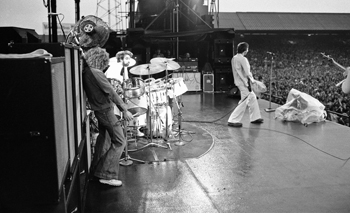
Click to view larger version. 31 May 1976, The Valley, Charlton, U.K., for the Who Put The Boot In ’76, stack of JBL 4560 bins with JBL 2350 horn topped by 2440 slant lens at the front edge of the stage for sidefill foldback; similar stack visible behind Keith. To the left of Bob Pridden’s Mavis desk, two additional JBL 4560 stacks with 2440 slant lenses and JBL 2350 horns, topped by JBL 2345 compact radial horns, dedicated to the prerecorded tape playback.
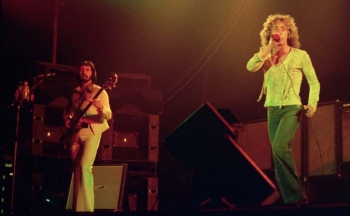
Click to view larger version. 22 May 1976, Colmar, France, two JBL 4560 stacks with 2440 slant lenses with JBL 2350 radial horns and JBL 2345 compact radial horns, dedicated to the prerecorded tape playback.
- Two Showco 30-channel, 8-output Superboards; each channel has a three-stage parametric EQ.
- Two four-way crossover master panels are used to control the division and assignment of the four frequency bands.
- Two graphic equalizers.
- Two Urei 1176-LN limiters.
- Patch bay.
- Oscilloscopes.
- For vocal effects:
- Eventide three-channel 400-millisecond electronic delay
- Eventide Instant Phaser
- Roland Space Echo
- For guitar effects:
- Three WEM Copicat echo units (each with tape measured to specific length to vary the delay)
Bob Pridden controls the onstage monitor mix with Mavis boards from stage-left behind the PA speakers; Dick Hayes mixes guitars, vocals, effects and overall balance. Showco’s B.J. Schiller mixes the drum and house mix.
Monitors (designed by Bob Pridden)
Two systems: one for pre-recorded tape playback residing at the back corners, the other at stage-side for live sound foldback.
- Four stacks, each comprising:
- Two JBL K130 15″ speakers mounted in 4560 bass horns.
- One 2350 horn connected to a 2482 driver.
- One oval horn fitted with a 45° slant lens, connected to a 2482 driver.
- Two 2402 tweeters.
- One 90° radial horn with 2420 driver.
Plus front-stage floor wedge monitors for vocals, one or two per position.
UK/Europe
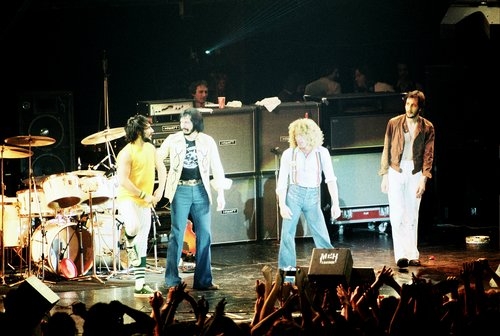
27 March 1976, Winterland Auditorium, MEH-supplied floor wedge monitors.
For UK/European shows, the PA was supplied by Marshall Equiment Hire (MEH) of London, and was similar to the North America setup.
- Gauss-loaded JBL bass, mid-range and high-range speaker and horn units
- Crown DC-300 power amplifiers
- Three Mavis mixer consoles with 15 input channels and 4 output channels each
- One Alice mixer console with 10 input channels, 6 output channels
- One Scully 4-track tape machine
- Two vari-speed Revox tape machines (as backup)
- Two WEM Copicat echo units
- One Eventide 3-channel 400-millisecond electronic delay
- One Eventide Instant Phaser unit
- Shure and Neumann microphones
PA speakers comprised:
- Four Showco long-throw bass bins
- Eight JBL 4560 1 x 15″ bass bins
- Four Roy Clair 2x12″ mid-range cabs
- Eight JBL 4550 2x15″ bass bins
- 12 JBL 2350/2482 mid-range radial horns
- Eight JBL 2395/2482 mid-range lens units
- Four JBL 2356/2440 mid-range/long range radial horns
- 12 JBL 2345/2420 high-range radial horns
- 24 JBL 075 high frequency transducers
- 25 Crown DC300A power amplifiers
Excerpts from 1975 International Musician and Recording World interview with The Who’s road crew for the October 1975 New Bingley Hall gigs:
MEH’s Derek Dickinson explained “[The Gelf mixing console is] a 30-channel desk and you can record out from each channel. You can either send it before or after the EQ section, so you can get 30 in and 30 out. Then there’s four effects send and returns on each channel, so you can put things in like a phaser or, as The Who are doing, a Wem Copicat, or a limiter, or a digital delay line. It’s got ten sub-groups, of which 9 and 10 are quadrophonic, and there’s a five-way crossover. Most desks have built-in reverb, but it’s not really needed on this one. With the sends and returns, you can put anything in. Each channel has got full parametric equalisation (you can pick a frequency and either cut or boost that frequency) and there’s a high pass filter and a low pass filter as well.
“All the faders on the desk are Penny and Giles which are the best you can buy. They’re used on the Neve desks. Obviously, each channel can be switched into whatever sub-group you want, and you can record out from the masters, which is after the sub-groups but before the masters.”
The desk is the same one that was used for Frank Sinatra at the Albert Hall earlier this year, when the sound system was highly praised by both Sinatra and the press. It was designed by Joe Brown and Martin Birch, and put together by Ken Fleg. “It certainly is a very good desk,” added Derek. “I do all the mixing for Bad Company when they’re on the road, so I’ve used desks all around the world, and it’s definitely the best desk I’ve ever used.”
The P.A. stacks at either side of the stage were split into two separate sections — one half was on a platform beside the stage, while another section was stacked on a Flying Carpet scissor-lift. The reason for this was to throw the sound out to the back of the auditorium, without deafening those at the front.
Dick Hayes, the man out front slaving over a hot Gelf desk, was working hard on this number. Each time Townshend went into a lead break, the level of the guitar had to be brought up via the desk. It was miked up from one of Townshend’s bottom cabinets, and cut through as clear as crystal.

Ca. 1975, overhead view of arena stage setup, showing flown stacks and placement of front-of-house mixing desk platform.
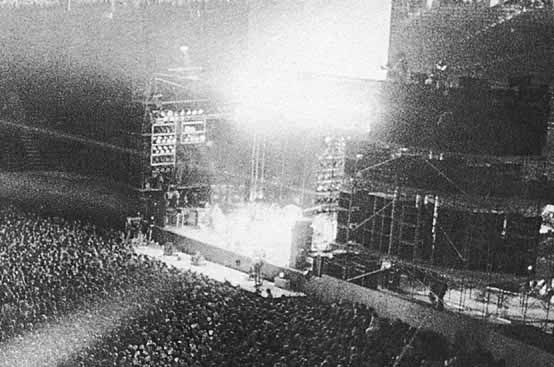
Ca. 1975, stadium setup for PA, showing considerably larger array than arena setup, above.
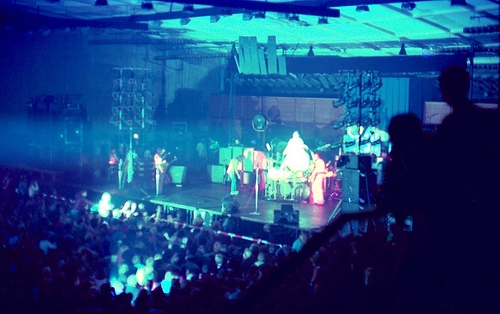
6 Nov. 1975, hall setup (i.e., no flown speakers) at Friedrich Eberthalle in Ludwigshafen, Germany. Photo courtesy Affendaddy. See Affendaddy’s photo stream on Flickr.

March 1976, stage setup at Winterland Auditorium, San Francisco. Courtesy thewho.org.
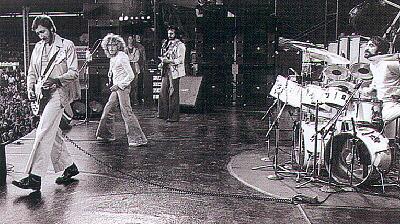
June 1976, with stage-left view of floor wedge monitors and dual monitor stacks behind John to the right of his Sunn/Stramp amp rack.
New Bingley Hall, Stafford, October 1975
Click to view larger versions. Details of the MEH-supplied PA used at New Bingley Hall, Stafford, 3 and 4 Oct. 1975, as featured in International Musician magazine, December 1975.
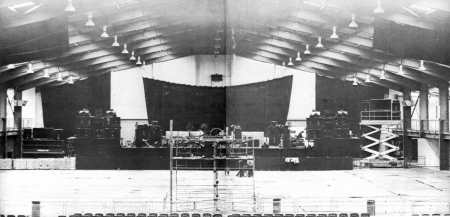
New Bingley Hall, Stafford, 3 and 4 Oct. 1975, PA setup.
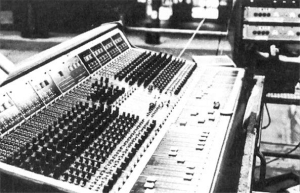
New Bingley Hall, Stafford, 3 and 4 Oct. 1975, Gelf 30-channel mixing desk.
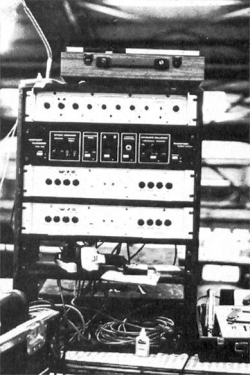
New Bingley Hall, Stafford, 3 and 4 Oct. 1975, effects rack including Eventide Instant Flanger, and WEM Copicat at right.
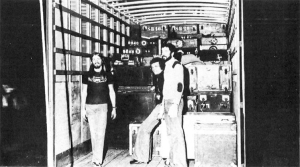
New Bingley Hall, Stafford, 3 and 4 Oct. 1975, the road crew loading up after the show
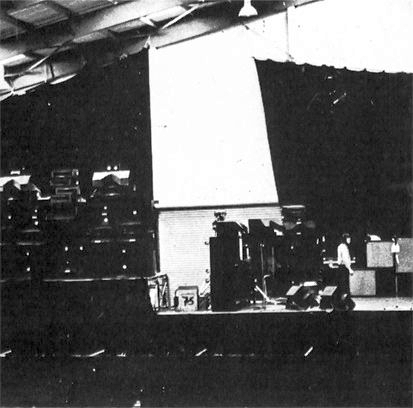
New Bingley Hall, Stafford, 3 and 4 Oct. 1975, the stage-right side of the P.A. stacks.
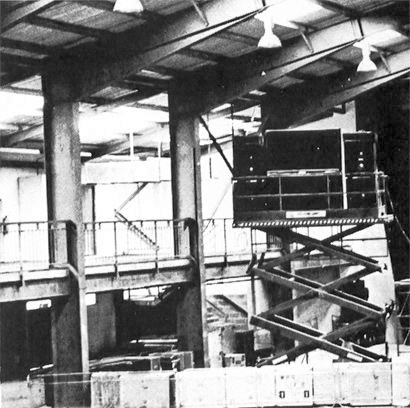
New Bingley Hall, Stafford, 3 and 4 Oct. 1975, the stage-right portion of the P.A., “flown” on a scissor lift.
Pavillon de Paris, March 1976
Click to view larger versions. Details of the MEH-supplied PA used at Pavillon de Paris, 1 and 2 March, 1976. Photos: “A French Fan”
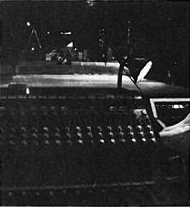
MAVIS desk
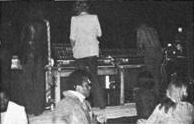
Notable event: 31 May, 1976
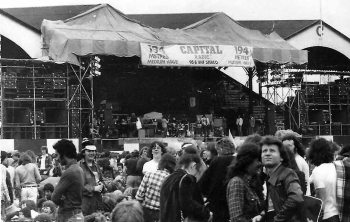
Click to view larger version. 31 May 1976, The Valley, Charlton, U.K., for the Who Put The Boot In ’76, a view of the Tasco-built PA.
The Who set the record for the loudest group ever. Tasco built the PA specially for the Charlton show at a cost of £7,000(?), and was reportedly audible 10 miles from the stadium. The Guinness Book of World Records entry:
Loudest Pop Group
The amplification for The Who concert at Charlton Athletic Football Ground, London, England, May 31, 1976, provided by Tasco PA system, had a total power of 76,000 watts from eighty 800 W Crown DC 300 A amplifiers and twenty 600 W Phase Linear 200’s. The readings at 50 m (164 ft) from the front of the sound system were 120 decibels. Exposure to such noise levels is known to cause PSH — Permanent Shift of Hearing or partial deafness.
The £100,000 lighting system for the show: 30x Par 64 1,000-watt lamps, 32x Leko 1,000-watt lamps, Hydraulic “Genie” towers, Electrosonic control desks, Electrosonic Dimmer packs, Strand Patt 765 follow spots, 38 “00” three section truss, Vermet towers, Ramport Lasers.
Richard Barnes:
“The whole tour was a massive operation involving … 30 tons of equipment … Although loud, the sound was clear and sharp. The sound system specially built for the show by Tasco, and costing £7,000 just for that night alone, had never before been used in England. The long throw bass speakers ensured that even people at the back got high quality sound … At the climax of Listening to You all the £100,000 lights including the huge arc lights set up behind the group, facing out into the audience, were switched on, and the effect from this simple piece of theatrics produced one of rock’s greatest and most climactic moments…”
Crew for The Who Put The Boot In ’76, from Melody Maker, 27 May, 1976:
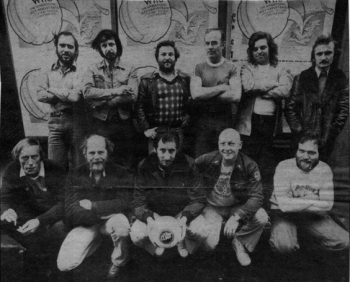
Click to view larger version. Left to right, back row: Bill Curbishley (Who manager), John Entwistle, Harvey Goldsmith (tour promoter), Danny Fielding (head of security), Edwin Shirley (in charge of trucking), Keith Altham (press officer); front row: Dave Cohen (lighting engineer), Bob Pridden (sound engineer), Pete Towshend, John Wolff (in charge of the laser) and Mike Goode (site manager).
The Who’s permanent road crew at this time:
- John “Wiggy” Wolff (Lasers/Production Manager)
- Bob Pridden (Sound Engineer)
- Roger Searle (Lights Tech)
- Mick Double (Drum Tech)
- Alan Smith (Sound Engineer/Guitar Tech)
- Alan Rogan (Guitar Tech)
- Tony Haslam (Lights Tech)
- Jim Hubbard (Lights Tech)
- Bill Harrison (Bass Tech)
- Dick Hayes (Sound Tech)
Resources and Information
Acknowledgements
- Bob Heil
- Dave Goessling
Special thanks to John Hughes (john@pureneasy.fsnet.co.uk) for assistance with this page.
Sources and related sites:
- Cream amplification: twtd.bluemountains.net.au/cream/amplification.htm (archived)
- Pink Floyd amplification: geocities.com/deadhead20.geo/PFlive.html (archived)
- The Grateful Dead’s “Wall of Sound”: dead.net/cavenweb/deadfile/newsletter19soundrap.html (archived)
- Max The Mod: westminsterinc.com/who1965/equip.htm (offline).
- Rock Hardware: The Instruments, Equipment and Technology of Rock. Edited by Tony Bacon. Harmony Books. 1981.
- The Who Concert File, by Joe McMichael and ‘Irish’ Jack Lyons. Omnibus Press.
- Guitar Player: The Who’s Sound System. How it grew from 200 to 75,000 watts. By Steve Caraway and Tom Wheeler. November 1977.
- repfoto.com.
- Sunn: Unofficial Sunn Museum and The Sunn Shack (archived)
- Watkins Guitar World: watkinsguitars.co.uk
- ML Executives: mlexecutives.org (archived)
Articles
- “Rock hall hails Heil’s wizardry. Metro-east native created equipment for stars.” From the Belleville (Illinois) News-Democrat (archived version), Tuesday, 9 May, 2006
- “Bob Heil: A Living Live-Sound Legend,” from Musician’s Friend (archived), May 2006
- Guitar Player: The Who’s Sound System. How it grew from 200 to 75,000 watts. By Steve Caraway and Tom Wheeler. November 1977.
Manufacturer’s sites
- Watkins Electric Music (WEM): wemwatkins.co.uk
- Bob Heil: heilsound.com
- Marshall Amplification: marshallamps.com
- Vox: voxshowroom.com
- Crown Audio: crownaudio.com
- Showco: showco.com
- Phase Linear History: phaselinearhistory.com
- Shure: shure.com
- Sunn: sunnamps.com
- Revox: revox.ch and reeltoreel.de
- Martin Audio: martin-audio.com
- Midas: midasconsoles.com
